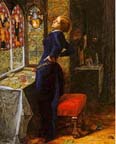
D.G. Rossetti's Lady Lilith represents a paradox since she can be viewed as both an excessively sexualized object as well as an empowered woman. Rossetti paints Lady Lilith in an ambiguous setting which appears to be neither indoors or outdoors. At first glance, the Lady seems to be reflecting on her appearance as she strikes a relaxed pose in the intimate setting of her boudoir. The reflection of the candles indicates that the mirror in the top left corner is indeed a mirror and not a window into the outside world. Surprisingly, the mirror also reflects a wooded landscape instead of expected bedroom objects. The flowers which surround Lady Lilith add to the ambiguity of the setting.
The painting focuses on the Lady's seductive beauty. Her loose, flowing hair and nearly removed clothing emphasize her voluptuous, overtly sexual figure. Her revealing attire and lack of tight-fitting corsetry perhaps symbolize her refusal to fit into socially inhibiting roles and constraints. although her physical appearance seems to suggest a sexual invitation to the male viewer, her facial expression does not encourage anyone to gaze on her. Lady Lilith does not engage in any eye contact, but instead toys with her hair and delights in her own reflection. Thus, she displays her sexuality for herself, not for a male viewer.

Lady Lilith's self-absorbed gaze both parallels male voyeurism and reverses it. Unlike female subjects such as D.G. Rossetti's Blessed Damozel who looks longingly from heaven down on her beloved and Millais's Mariana who continually pines for her beloved at the window, Lady Lilith is completely satisfied with herself. In contrast to the tenderness and submissiveness expressed by many of Rossetti's other fair ladies, Lady Lilith's expression exudes haughtiness and deviousness which would be more likely to inspire fear rather than desire in the male viewer. Sonnet LXXVIII entitled "Body's Beauty" from D.G. Rossetti's The House of Life portrays Lady Lilith as a dangerous seductress. The poem sheds light on many of the details in the painting, including the symbolism of the flowers:
Of Adam's first wife, Lilith, it is told
(The witch he loved before the gift of Eve,)
That, ere the snake's, her sweet tongue could deceive,
And her enchanted hair was the first gold.
And still she sits, young while the earth is old,
And, subtly of herself contemplative,
Draws men to watch the bright web she can weave,
Till heart and body and life are in its hold.
The rose and poppy are her flowers; for where
Is he not found, O Lilith, whom shed scent
And soft-shed kisses and soft sleep shall snare?
Lo! as that youth's eyes burned at thine, so went
Thy spell through him, and left his straight neck bent
And round his heart one strangling golden hair. [Collected Poems, 161]
This sonnet portrays Lady Lilith as a snake, a witch and an enchantress capable of ensnaring and "strangling" men in her hair. In the painting, Rossetti makes Lady Lilith's long flowing hair the central focus of the composition. Males are not allowed to be voyeurs of her physical appearance at a safe distance. With her lethal beauty, Lady Lilith can lure men closer until she has their "heart and body and life."
Questions
1. Does D.G. Rossetti's attitude towards Lady Lilith in the poem coincide with his depiction of her on canvas?
2. "Body's Beauty" marks a departure from many of D.G. Rossetti's other "fair lady" paintings and poems in which he espouses sexist, uninvestigated male-female relationships. In contrast to his portrayal of the Blessed Damozel, a rapt and dreaming woman in heaven, Rossetti emphasizes Lady Lilith's carnal, earthly beauty. In terms of a feminist critique, is it significant that Rossetti portrays Lady Lilith as "subtly of herself contemplative" rather than as lost in a reverie of love?
3. In the sonnet, is Lady Lilith's power to leave a man's "straight neck bent" a metaphor for castration?
4. By placing Lady Lilith in a modern, upper-class setting and having her perform a benign, ordinary activity is D. G. Rossetti trying to humanize her? Is she still an evil, witch-like, mythological figure?
5. How would an upper- and middle-class Victorian audience have responded to this painting? Would Lady Lilith's revealing clothing have been regarded as offensive?
Related Materials
- The Beauty as Power in in Rossetti's Lady Lilith
- A Dialectic of Beauty in Rossetti's Lady Lilith
- The Modern Lilith
Bibliography
Rossetti, Dante Gabriel. Collected Poetry and Prose. New Haven: Yale University Press, 2003.
Last modified 27 June 2020